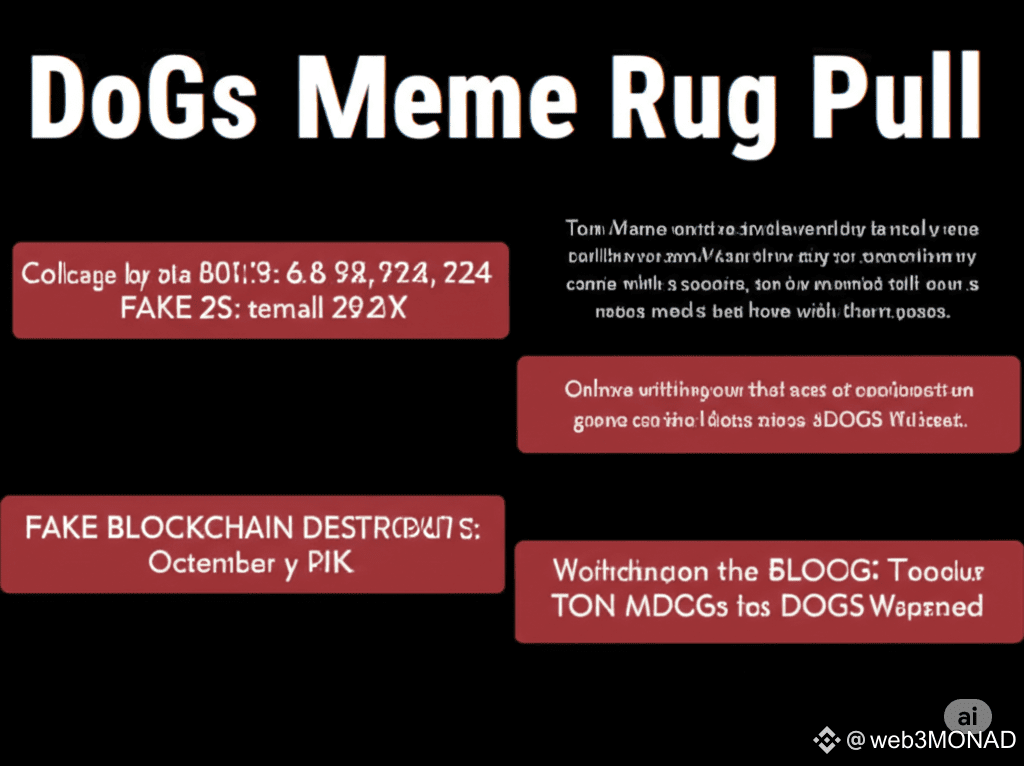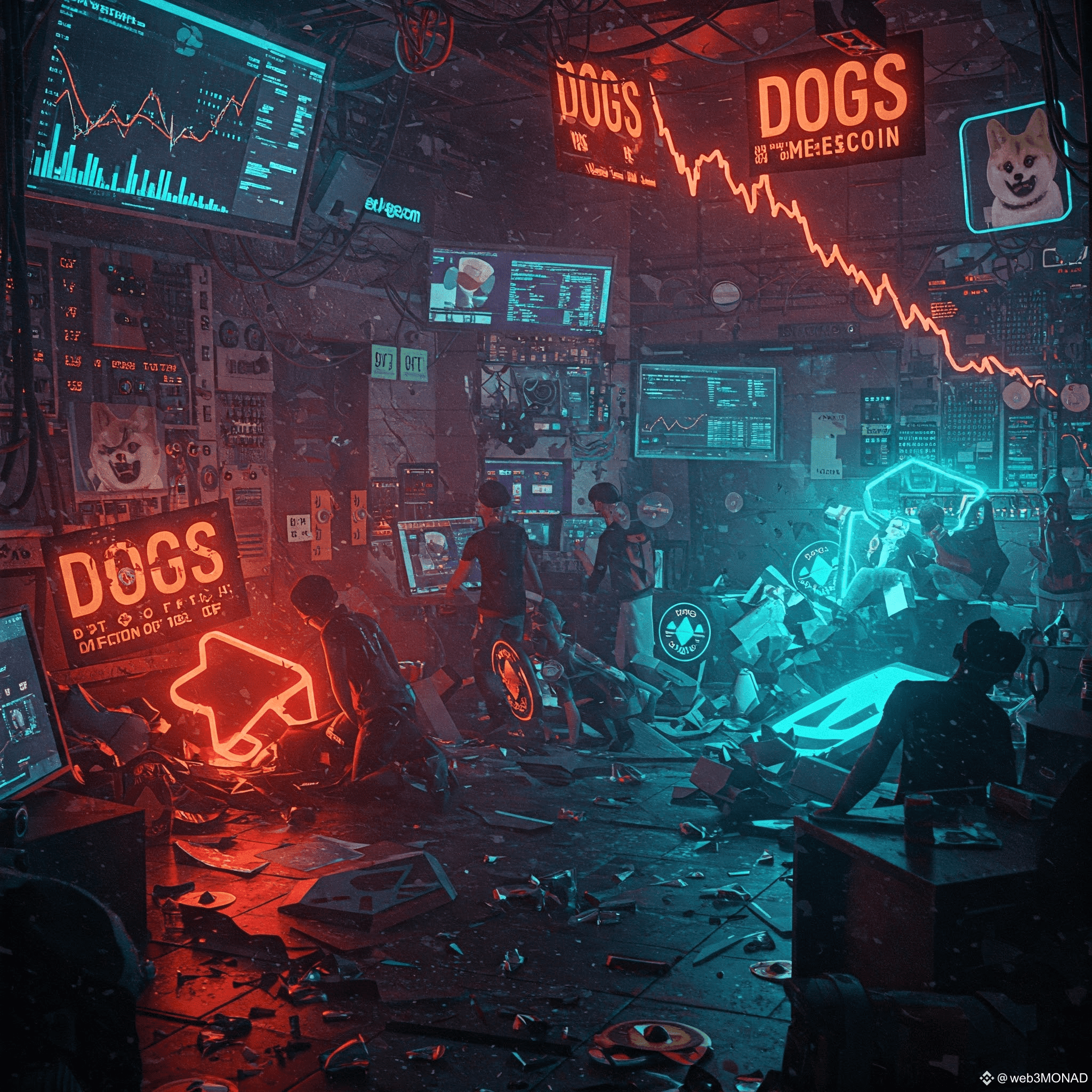
The DOGS Memecoin Rug Pull Scam of August 2024: A Global Deception Fueled by Telegram and Binance
In August 2024, the cryptocurrency world was rocked by one of the most audacious memecoin scams in recent history: the DOGS memecoin rug pull. Orchestrated through Telegram and amplified by the credibility of Binance, the scam misled thousands of investors worldwide, resulting in millions in losses. This article delves into the timeline of the DOGS memecoin scam, the fake events that fueled its hype, and how scammers leveraged Telegram and Binance to deceive the global crypto community.
The Rise of DOGS Memecoin: A Perfect Storm of Hype
Memecoins, cryptocurrencies driven by internet memes and community enthusiasm, have been a volatile yet popular segment of the crypto market. In 2024, memecoins saw unprecedented mainstream attention, with DOGS emerging as a standout due to its ties to the Telegram ecosystem. Launched as a mini Dapp on Telegram, DOGS was marketed as a fun, community-driven token with a charitable angle, promising to reward users with tokens for engaging with the platform. Its branding, centered around cute dog imagery and Telegram’s massive user base, tapped into the viral meme culture that had propelled tokens like Dogecoin to fame.
The DOGS token gained significant traction when it was announced for listing on Binance Launchpool, a platform that allows users to stake assets to earn new tokens. On August 14, 2024, the DOGS team teased a major announcement regarding the token’s listing, creating a wave of anticipation. By August 26, 2024, Binance confirmed the listing of DOGS with trading pairs like DOGS/USDT, DOGS/BNB, DOGS/FDUSD, and DOGS/TRY, lending the project an air of legitimacy.
The Scam’s Foundation: Telegram as the Breeding Ground
Telegram, a messaging app favored by crypto enthusiasts for its privacy features and large group channels, was the primary platform for the DOGS scam. Scammers exploited Telegram’s ecosystem by creating fake groups and channels that mimicked legitimate crypto communities. These channels were meticulously crafted, copying profile pictures, pinned messages, and admin usernames to appear authentic. Using bots and coordinated shilling, scammers flooded these channels with exaggerated claims about DOGS’ potential, promising high returns and exclusive opportunities.
One common tactic was the use of “pump and dump” schemes, where scammers artificially inflated DOGS’ price through coordinated buying, only to sell off their holdings at the peak, leaving retail investors with worthless tokens. Telegram’s privacy settings, such as end-to-end encryption and anonymous usernames, allowed scammers to operate without revealing their identities, making it difficult for victims to trace them.
Fake Events and Deceptive Marketing: A Year-Long Charade
Throughout 2024, the DOGS scam was propped up by a series of fake events and misleading announcements designed to build trust and sustain hype. Here’s a timeline of key deceptive tactics:
1. January–March 2024: Initial Hype and Fake Partnerships
Scammers began promoting DOGS on Telegram, claiming partnerships with major crypto exchanges and tech companies. These partnerships were unverifiable, often accompanied by polished but vague whitepapers and websites. Social media posts on platforms like X amplified these claims, with bots and paid influencers creating the illusion of widespread community support.
2. April–June 2024: Coordinated Shilling and Fake Airdrops
The DOGS team announced a series of “airdrop events” on Telegram, promising free tokens to users who joined their channels or completed tasks. These airdrops were designed to attract new investors, many of whom were first-time crypto users. In reality, the airdrops were either non-existent or distributed worthless tokens. Coordinated shilling by fake accounts on Telegram and X further drove FOMO (fear of missing out), with messages urging users to “buy now or miss out.
3. July 2024: Binance Launchpool Announcement
The turning point came when Binance announced DOGS as a Launchpool project. This move lent the token unprecedented credibility, as Binance is one of the world’s largest and most trusted crypto exchanges. Scammers capitalized on this, using Telegram to spread fake updates about the Launchpool, including claims of guaranteed high returns and insider tips. Many investors, trusting Binance’s vetting process, poured funds into DOGS without scrutinizing the project’s fundamentals.
4. August 2024: The Rug Pull
On August 26, 2024, as DOGS was listed on Binance, its price surged due to the hype. However, shortly after the listing, the developers executed a classic rug pull. They withdrew liquidity from decentralized exchanges, drained the token’s value, and disappeared, shutting down their Telegram channels and website. Investors were left holding worthless tokens, with losses estimated in the millions. On-chain data later revealed that a small number of wallets held the majority of DOGS tokens, a common red flag for rug pulls.
How Binance’s Involvement Amplified the Scam
Binance’s role in the DOGS scam, while likely unintentional, was pivotal. The exchange’s decision to list DOGS on its Launchpool gave the project a veneer of legitimacy that scammers exploited. Binance’s massive user base and reputation as a trusted platform encouraged retail investors to participate without conducting thorough due diligence. The listing also attracted first-time crypto investors, who were particularly vulnerable to the scam’s promises of quick profits.
Scammers further manipulated Binance’s platform by cashing out fraudulent tokens through shared deposit wallets, a tactic seen in other memecoin scams like the TRUMP token frenzy, which netted scammers $857.5 million. The lack of stringent vetting for Launchpool projects allowed DOGS to slip through, highlighting gaps in Binance’s due diligence process.
Red Flags Ignored: Why the World Fell for It
The DOGS scam succeeded because it preyed on common vulnerabilities in the crypto market:
- **FOMO and Hype**: The promise of high returns, amplified by Telegram’s viral marketing and Binance’s endorsement, drove emotional investing.
- **Lack of Transparency**: The DOGS team remained anonymous, and the project lacked smart contract audits, a major red flag that went unnoticed by many.
- **Telegram’s Anonymity**: The platform’s privacy features allowed scammers to operate without accountability, using fake channels and bots to manipulate investors.
- **Binance’s Credibility**: The exchange’s involvement gave DOGS an undeserved stamp of approval, lulling investors into a false sense of security.
Aftermath and Lessons Learned
The DOGS rug pull was part of a broader wave of memecoin scams in 2024, which saw over $500 million lost to rug pulls and scams globally. The incident sparked outrage on platforms like X, where users criticized Binance for its role and called for stricter regulations on memecoin listings. Investors who lost funds had little recourse, as the anonymous nature of the scammers and Telegram’s privacy features made it nearly impossible to track them down.
To avoid falling victim to similar scams, investors should:
- **Conduct Thorough Research**: Verify project details, including team identities, smart contract audits, and token distribution. Tools like GeckoTerminal and Etherscan can help identify red flags like irregular token allocation or unlocked liquidity.
- **Beware of Hype**: Avoid projects driven solely by social media buzz or influencer endorsements, especially on Telegram.
- **Skepticism of Listings**: Even listings on reputable exchanges like Binance do not guarantee legitimacy. Always double-check project fundamentals.
- **Secure Accounts**: Use strong passwords and enable two-factor authentication on platforms like Telegram to protect against phishing and hacking attempts.
Conclusion

The DOGS memecoin rug pull of August 2024 was a stark reminder of the risks inherent in the memecoin market. By leveraging Telegram’s anonymity and Binance’s credibility, scammers orchestrated a year-long deception that fooled investors worldwide. The scam’s success underscores the need for greater vigilance, better regulatory oversight, and improved vetting processes by exchanges. As memecoins continue to dominate headlines in 2025, investors must prioritize due diligence and skepticism to navigate this volatile and often treacherous space.


